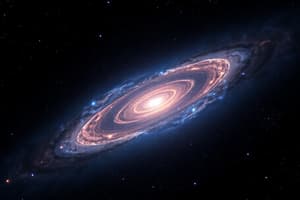Podcast
Questions and Answers
How long does it take light to travel from Jupiter to Earth if Jupiter is 742,560,000 km away?
How long does it take light to travel from Jupiter to Earth if Jupiter is 742,560,000 km away?
Approximately 41.2 minutes
How many light years away is the Andromeda Galaxy, which is 2.34 x 10^19 km from Earth?
How many light years away is the Andromeda Galaxy, which is 2.34 x 10^19 km from Earth?
Approximately 2.5 million light years
If light takes 2.5 years to reach an object in space, how many kilometers away is the object?
If light takes 2.5 years to reach an object in space, how many kilometers away is the object?
Approximately 23.6 trillion kilometers
How are stars born?
How are stars born?
What causes an average star to become a red giant?
What causes an average star to become a red giant?
How is the lifecycle of an average star different from that of a supergiant?
How is the lifecycle of an average star different from that of a supergiant?
What determines if a star will become a red giant or a supergiant?
What determines if a star will become a red giant or a supergiant?
What is the core of a white dwarf?
What is the core of a white dwarf?
What happens to a white dwarf?
What happens to a white dwarf?
What does the HR diagram plot?
What does the HR diagram plot?
What is apparent magnitude?
What is apparent magnitude?
What is absolute magnitude?
What is absolute magnitude?
Explain why Star B, with -1 apparent magnitude, is closer to Earth than Star A, which has 0.5 apparent magnitude.
Explain why Star B, with -1 apparent magnitude, is closer to Earth than Star A, which has 0.5 apparent magnitude.
What classification would Aldebaran belong to?
What classification would Aldebaran belong to?
What is the difference between blue and red supergiants?
What is the difference between blue and red supergiants?
What is the absolute magnitude and temperature of the Sun?
What is the absolute magnitude and temperature of the Sun?
Flashcards are hidden until you start studying
Study Notes
Light Year and Speed of Light
- A light year is the distance light travels in one Earth year, defining vast astronomical distances.
- Light speed is approximately 300,000 km/s, making it the universe's speed limit.
- Light can circle Earth 7.5 times in only one second.
- A year consists of 31,536,000 seconds, enabling the calculation of light year distances.
Stellar Lifecycle
- Stars originate from nebulae, where gas and dust clump together under pressure and density.
- Hydrogen fusion begins when conditions are sufficiently high in temperature and pressure, leading to main sequence status.
- A star's mass influences its temperature, brightness, lifespan, and ultimate fate.
Death of an Average Star
- An average star will not fuse helium in its core, leading to hydrogen fusion in its outer layers.
- This makes the star expand into a red giant, eventually shedding its outer atmosphere to form a planetary nebula.
- The remaining helium core becomes a white dwarf, which cools to eventually form a brown dwarf.
Death of a Massive Star
- A massive star continues fusion up to iron and expands into a red supergiant.
- A core collapse occurs when gravitational forces exceed energy output, resulting in a supernova.
- The collapsed core may become a neutron star or a black hole depending on remaining mass.
Hertzsprung-Russell (HR) Diagram
- The HR Diagram plots the brightness of stars against their temperature, with temperature increasing towards the center of the graph.
- All stars begin in the main sequence and later transition as they evolve.
Magnitude of Stars
- Apparent magnitude refers to how bright a star appears from Earth; absolute magnitude measures intrinsic brightness at 32.6 light years away.
- A lower magnitude value indicates a brighter star, such as the Sun, with an apparent magnitude of -26.74 and an absolute magnitude of 4.83.
Stellar Classification and Questions
- Stars are classified based on various characteristics which predict their lifecycle stages, such as whether they will become a red giant or supergiant.
- Key characteristics include absolute magnitude, apparent magnitude, and stellar temperature.
- Example: Star A with -6 absolute magnitude and 0.5 apparent; Star B with -0.2 absolute and -1 apparent magnitude emphasizes proximity.
Studying That Suits You
Use AI to generate personalized quizzes and flashcards to suit your learning preferences.




